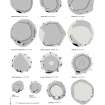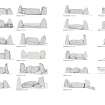North Strone
Recumbent Stone Circle (Neolithic) - (Bronze Age)
Site Name North Strone
Classification Recumbent Stone Circle (Neolithic) - (Bronze Age)
Alternative Name(s) North Strone, Alford
Canmore ID 17588
Site Number NJ51SE 2
NGR NJ 5844 1389
Datum OSGB36 - NGR
Permalink http://canmore.org.uk/site/17588
- Council Aberdeenshire
- Parish Alford
- Former Region Grampian
- Former District Gordon
- Former County Aberdeenshire
NJ51SE 2 5844 1389
For small cairns and rig in the area around, see NJ51SE 2.
NJ 5844 1389 Stone Circle (OE) (Remains of)
OS 6" map, 1901.
North Strone, Alford: The stones composing the circle are seventeen in number, they are all short and not very broad. The recumbent stone and pillars are extremely small. The five stones on the NW were recently raised from a prostrate position and erected at intervals believed to be in keeping with the spaces between the undisturbed stones on the E and SW. On the E side of the circle some human bones, and chips of what must have been an ornamented urn were found. There were marks of four graves with nothing in them. The whole space enclosed by the stones was originally paved with rough stones set together; seven graves were found lying nearly E and W within the circle, all previously opened. One contained bones, part of a clay urn with incised decoration; another had several pieces of bone, a tooth and two bits of flint; and in the rest only skeletons could be traced. The approximate circumference of the circle is 170'. The diameters may be stated as 67' x 62'. The recumbent stone whose dimensions are, length 4'8", present breadth (originally the height), 2'4", and thickness 1'7", has been pushed over from its original position between the two pillars.
(F R Coles 1902; Anon 1897).
A recumbent stone circle, c. 20.5m diameter, of unusually small stones. Set into a bank, only 4 stones, including the E flanker, appear to be in situ; the remainder have tumbled. The site is heavily overgrown. Surveyed at 1/2500.
Visited by OS (RL) 17 September 1968.
Field Visit (6 September 1994)
This stone circle is situated at the NE end of the broad summit ridge of Strone Hill, a position which would afford an extensive outlook to N and E were it not for the broom which cloaks this side of the hill. It stands within an area of small cairns and there is a small area of rig to the NW (NJ51SE 47).
The stone circle has comprised at least nineteen stones set on the inner edge of a stony bank 1.2m thick and 0.25m high which measures 22m in overall diameter. Four stones on the E appear to be in situ, along with the E pillar flanking the recumbent, the tallest being 1m high. The recumbent, which is on the S side of the circle and which measures 1.6m by 0.7m, may also be in its original position, but if so it has been placed within the bank, slightly forward of its flanking pillars. The other stones have fallen, most of them lying on the inner edge of the bank. Twelve stones, including the recumbent and its flankers, are of pink granite, and the rest are grey, but no coherent pattern can be discerned in the disposition of the two types. A roughly rectangular stony platform abutting the inner face of the bank on the W has probably been created by recent disturbance.
(CRAIG94 104)
Visited by RCAHMS (SDB) 6 September 1994.
Measured Survey (6 September 1994)
RCAHMS surveyed the recumbent stone circle at North Strone with plane-table and alidade on 6 September 1994 at a scale of 1:100. The resultant plan was redrawn in ink in 1995.
Field Visit (25 May 1999 - 26 May 1999)
This unusual recumbent stone circle stands at the top of a long slope dropping away to the NE at the eastern end of Strone Hill. Excavated and partly restored at the behest of Miss Maria Farquharson of Haughton House, Alford, at the end of the 19th century, the circle is once again ruinous and only the E flanker (3) and three stones on the E arc (6–8) remain upright. Nevertheless, it measures about 18.5m in diameter and has comprised at least seventeen, or possibly eighteen (A), evenly spaced stones, apparently set out along the inner edge of a low stony bank 1.5m thick and no more than 0.2m in height. Unlike other recumbent stone circles, where the stones are typically large and imposing, here they are all comparatively small, not least the recumbent (2), a roughly rectangular block of dark pink aplite on the S, which measures only 1.5m in length and when upright would have stood no more than 0.8m high. This has fallen onto its back to expose a long support stone jutting forwards at an angle close to its E end; the block’s uneven summit now forms its N side. The W flanker (1), which has been the more slender of the two, has also tumbled backwards, but the S face of the upright E flanker (3) indicates the position of the leading edge of the setting; like the recumbent, and indeed most of the orthostats, both flankers are of dark pink aplite. At 1m in length and 0.75m in height respectively, both have been much the same height as the recumbent, though the roughly square top of the W flanker has led Burl to suggest that a stone now lying between it and the E end of the recumbent may have been its tip (2005a, 104). The remainder of the ring is made up largely of fallen blocks between 0.9m and 1.4m in length, and the only three orthostats that remain standing (6–8) are between 1m and 1.15m high. In this condition it is difficult to gauge whether the stones of the circle were consistently graded in height, but the shorter stones appear to be on the N arc. The enclosure in which they are set is slightly oval on plan, measuring 23m in maximum diameter overall, and the bank reaches its greatest thickness in front of the recumbent setting.
Visited by RCAHMS (ATW and KHJM) 25-6 May 1999


















































































